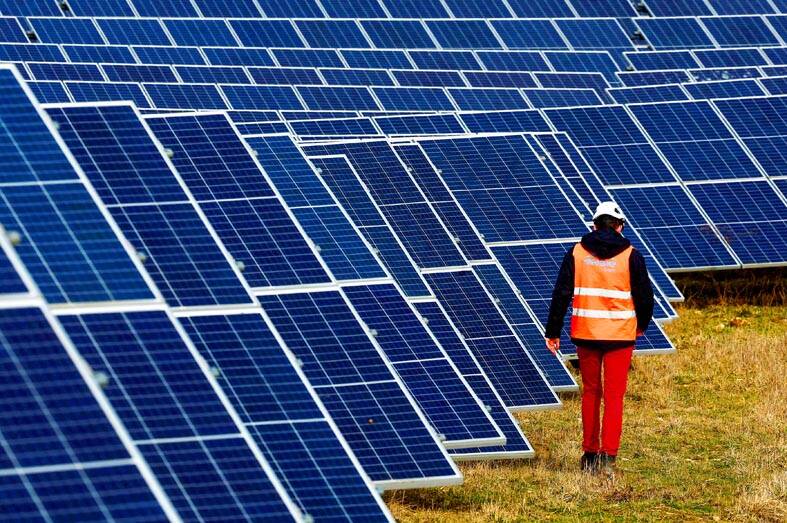Solar company Sino-American Silicon Products Inc (SAS, 中美晶) yesterday said it is negotiating with employees from its solar cell factory in Yilan County to take two-and-a-half weeks of leave as it plans to suspend production briefly to ride through a demand slump.
In an effort to mitigate financial pressure on their employees, SAS said it is discussing with labor representatives if they would consider an option to take special annual leave during the period from Jan. 7 to 24 when the Yilan factory is scheduled to halt production. Under this scenario, the employees would be able to take home full-month wages to cope with Lunar New Year holiday spending, SAS said yesterday.
“We are discussing how to arrange employees’ working hours, since production at the Yilan factory would be halted for two-and-a-half weeks from January 7 to the Lunar New Year holidays, due to high inventory,” company chairperson Doris Hsu (徐秀蘭) said.

Photo: Reuters
SAS, based in Hsinchu, made the comments after local media reported that it was forcing employees to take special annual leave in January due to low factory utilization. SAS said the report was not true and that they are still in the process of negotiating to find an optimal solution.
“It is not a done deal yet,” Hsu said. “We hope to wrap up the discussions no later than the end of December, or before the Christmas holidays.”
More than 100 employees would be affected by the production suspension, Hsu said.
The impact on the company’s revenue would be very minimal, as the solar cell and module business account for only about 2 percent of the company’s overall revenue, she said.
SAS blamed a slowdown in the construction of new solar energy plants in the domestic market for the sluggish solar cell demand. The company said that it originally expected the local solar industry to recover as local governments would speed up reviews of new solar energy projects after the presidential and legislative elections ended in mid-January this year. The progress fell short of the company’s expectations, Hsu said.
“Orders are coming in at a much slower rate than we had anticipated,” Hsu said. “We have been attacked from all sides.”
In addition to snail-paced new project launches, growing competition from low-price solar cells imported from “the third country” is depressing sales of locally made solar cells, Hsu said, referring to Chinese products imported via other countries.
About 30 percent of solar cells used in local solar energy plants originated from “the third country” this year, a spike from 20 percent before, she said.
SAS is striving to sell its solar products overseas, including in the US, to reduce its dependence on the local market, which is relatively small, it said, adding that the overseas market only made up 20 percent of the company’s solar sales.
Solar panel installation in Taiwan has reached 1.8 gigahertz, SAS said, adding that this meant the full-year installation could plummet 33 percent annually compared with 2.7 gigahertz last year.
The government has been curbing imports of solar cells and solar modules from China through third countries, primarily in Southeast Asia, but that has not yielded any substantial results.
The Industrial Development Administration yesterday said that it has not found any significant increases in solar cells being illegally imported from third countries. It attributed a drastic decline in the utilization of local solar factories to delays in new project launches.

The New Taiwan dollar is on the verge of overtaking the yuan as Asia’s best carry-trade target given its lower risk of interest-rate and currency volatility. A strategy of borrowing the New Taiwan dollar to invest in higher-yielding alternatives has generated the second-highest return over the past month among Asian currencies behind the yuan, based on the Sharpe ratio that measures risk-adjusted relative returns. The New Taiwan dollar may soon replace its Chinese peer as the region’s favored carry trade tool, analysts say, citing Beijing’s efforts to support the yuan that can create wild swings in borrowing costs. In contrast,

Nvidia Corp’s demand for advanced packaging from Taiwan Semiconductor Manufacturing Co (TSMC, 台積電) remains strong though the kind of technology it needs is changing, Nvidia CEO Jensen Huang (黃仁勳) said yesterday, after he was asked whether the company was cutting orders. Nvidia’s most advanced artificial intelligence (AI) chip, Blackwell, consists of multiple chips glued together using a complex chip-on-wafer-on-substrate (CoWoS) advanced packaging technology offered by TSMC, Nvidia’s main contract chipmaker. “As we move into Blackwell, we will use largely CoWoS-L. Of course, we’re still manufacturing Hopper, and Hopper will use CowoS-S. We will also transition the CoWoS-S capacity to CoWos-L,” Huang said

Nvidia Corp CEO Jensen Huang (黃仁勳) is expected to miss the inauguration of US president-elect Donald Trump on Monday, bucking a trend among high-profile US technology leaders. Huang is visiting East Asia this week, as he typically does around the time of the Lunar New Year, a person familiar with the situation said. He has never previously attended a US presidential inauguration, said the person, who asked not to be identified, because the plans have not been announced. That makes Nvidia an exception among the most valuable technology companies, most of which are sending cofounders or CEOs to the event. That includes

VERTICAL INTEGRATION: The US fabless company’s acquisition of the data center manufacturer would not affect market competition, the Fair Trade Commission said The Fair Trade Commission has approved Advanced Micro Devices Inc’s (AMD) bid to fully acquire ZT International Group Inc for US$4.9 billion, saying it would not hamper market competition. As AMD is a fabless company that designs central processing units (CPUs) used in consumer electronics and servers, while ZT is a data center manufacturer, the vertical integration would not affect market competition, the commission said in a statement yesterday. ZT counts hyperscalers such as Microsoft Corp, Amazon.com Inc and Google among its major clients and plays a minor role in deciding the specifications of data centers, given the strong bargaining power of